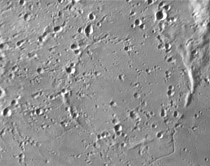Difference between revisions of "Stadius"
(Created page with "<div id="content_view" class="wiki" style="display: block"> =Stadius= {| class="wiki_table" | Lat: 10.5°N, Long: 13.7°W, Diam: 69 km, Depth: 0.65 km, [/R%C3%BCkl%2032 R...") |
|||
| Line 32: | Line 32: | ||
<br /> | <br /> | ||
==LPOD Articles== | ==LPOD Articles== | ||
| − | [http:// | + | [http://www2.lpod.org/wiki/March_24,_2005 Floods and Buckshot]<br /> [http://www2.lpod.org/wiki/October_26,_2007 Before and After]<br /> <br /> |
==Bibliography== | ==Bibliography== | ||
<br /> | <br /> | ||
Revision as of 19:32, 11 April 2018
Contents
Stadius
|
Lat: 10.5°N, Long: 13.7°W, Diam: 69 km, Depth: 0.65 km, [/R%C3%BCkl%2032 Rükl: 32] |
Table of Contents

François Emond Stadius is the large low enclosure to the right of center. About ten of the small craters visible here (as well as many to the northwest) have been assigned [/satellite%20feature letters] associated with Stadius. The ridge in the upper right leads to nearby [/Eratosthenes Eratosthenes].
Images
LPOD Photo Gallery Lunar Orbiter Images Apollo Images
Stadius was photographed during the missions of Apollo 15 and Apollo 17 (both from orbit). It might be an interesting pastime to try to detect the numerous craterlets of Stadius on orbital Apollo photos.- DannyCaes DannyCaes Sep 15, 2013.
Maps
([/LAC%20zone LAC zone] 58B3) LAC map Geologic map
Description
Description: Elger
([/IAU%20Directions IAU Directions]) STADIUS.--An inconspicuous though a very interesting formation, 43 miles in diameter, E. of [/Copernicus Copernicus], with a border scarcely exceeding 200 feet in height. Hence it is not surprising that it was for a long time altogether overlooked by Madler. Except as a known object, it is only traceable under very oblique illumination, and even then some attention is required before its very attenuated wall can be followed all round. It is most prominent on the E., where it apparently consists of a S. extension of the [/Eratosthenes Eratosthenes] mountain-arm, and is associated with a number of little craters and pits. This is succeeded on the S.E. by a narrow strip of bright wall, and on the S. by a section made up of a piece of straight wall and a strip curving inwards, forming the S. side. On the W. the border assumes a very ghostly character, and appears to be mainly defined by rows of small depressions and mounds. On the N.W., N., and N.E. it is still lower and narrower; so much so, that it is only for an hour or so after sunrise or before sunset that it can be traced at all. On every side, with the exception of the curved piece on the S., the wall consists of linear sections. The interior contains a great number of little craters and very low longitudinal mounds. Ten craters are shown in [/Beer%20and%20M%C3%A4dler Beer and Madler]'s map. Schmidt only draws fifteen, though in the text accompanying his chart he says that he once counted fifty. In the monograph published in the Journal of the Liverpool Astronomical Society (vol. v. part 8), forty-one are represented. They appear to be rather more numerous on the S. half of the floor than elsewhere. Just beyond the limits of the border on the N., is a bright crater with a much larger obscure depression on the E. of it. The former is surrounded by a multitude of minute craters and crater-cones, which are easily seen under a low sun. Though almost every trace of Stadius disappears under a high light, I have had little difficulty in seeing portions of the border and some of the included details when the morning terminator had advanced as far as the W. wall of [/Herodotus Herodotus], and the site was traversed by innumerable light streaks radiating from [/Copernicus Copernicus]. At this phase the bright crater, just mentioned, on the N. edge of the border was tolerably distinct.
Description: Wikipedia
Additional Information
Depth data from [/Kurt%20Fisher%20crater%20depths Kurt Fisher database]
- Arthur, 1974: 0.65 km
- Westfall, 2000: 0.65 km
- Viscardy, 1985: 0.65 km
- Cherrington, 1969: 0.36 km
Nomenclature
- Named for Johannes Stadius or Estadius (ca. May 1, 1527-June 17, 1579), a Flemish astronomer, astrologer, and mathematician.
- According to [/Whitaker Whitaker] (p. 215), this name appeared on [/Riccioli Riccioli]'s map, but was used to label a currently unnamed dark area. He does not make clear when or how the name became associated with the present feature. - JimMosher JimMosher
- In the [/IAU%20nomenclature IAU nomenclature] (as in the tradition that preceded it), [/satellite%20feature satellite features] are named after the nearest primary named feature, which may or may not have a physical relationship with them. In this case, as pointed out in the LPOD's, most of the many lettered craters named after Stadius were actually produced by secondary impacts from nearby (and much younger) [/Copernicus Copernicus]. - JimMosher JimMosher
LPOD Articles
Floods and Buckshot
Before and After
Bibliography
Who was Dobie?
According to T.W.Webb's Celestial Objects for Common Telescopes (Volume 1; The Solar System, chapter THE MOON), page 121, a certain Dobie noticed the speckled appearance of the interior of Stadius. Now, who was Dobie?
This page has been edited 1 times. The last modification was made by - tychocrater tychocrater on Jun 13, 2009 3:24 pm - afx4